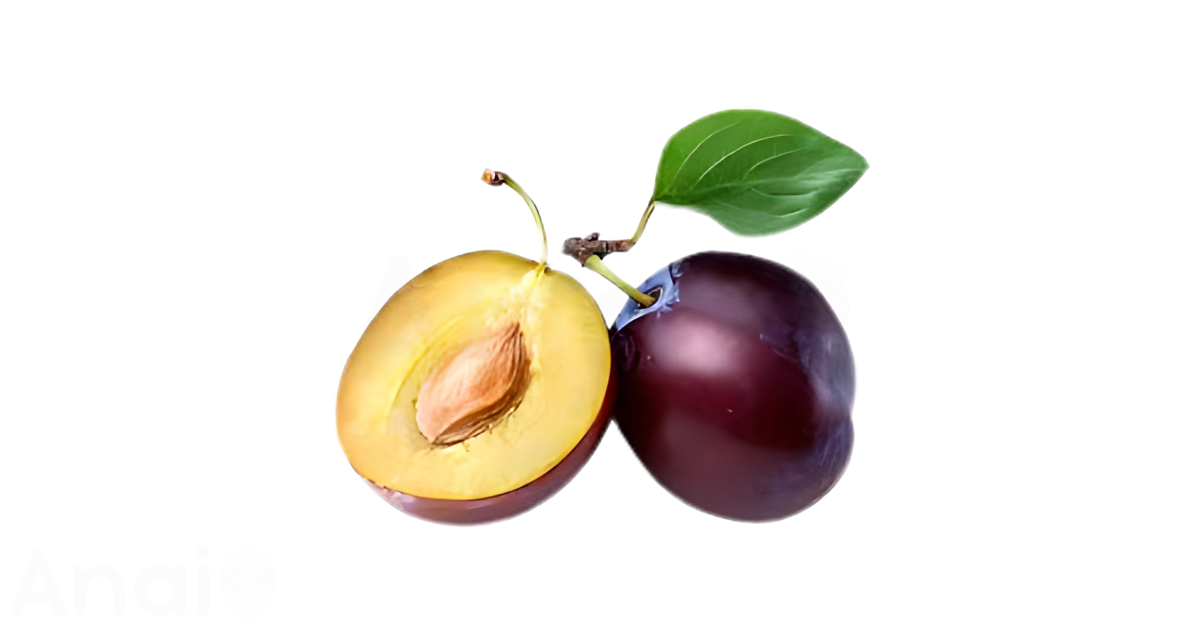Are Plums Good for You?
Yes, plums are exceptionally good for you. They are a nutrient-dense food, meaning they are low in calories but rich in vitamins, minerals, and health-promoting plant compounds (Zumpano, 2025). Both fresh plums and their dried version, prunes, are packed with fiber and antioxidants that support overall health (Elliott, 2025).
This article offers a comprehensive guide to plum nutrition, updated as of December 2025. We will explore the 13 functional health benefits of plums, plum nutrition facts, potential risks and side effects, and suitable substitutes. Additionally, we will cover popular plum diets, essential plum storage tips, 10 genius plum home remedies, the role of plums in weight management, and their use for specific health conditions.
13 Functional Health Benefits of Plums
Plums are more than just a sweet and juicy snack. They are a functional food packed with benefits that are increasingly validated by scientific research. Each health benefit listed below is supported by evidence from nutritional science and clinical studies.
1. Packed with Essential Nutrients
Plums offer an impressive nutritional profile for a very low-calorie count. A single medium-sized plum contains just 30 calories but delivers a good portion of your daily vitamin and mineral needs (Cervoni, 2024).
They are a fantastic source of vitamins C, A, and K. One plum provides about 7-10% of the recommended daily allowance for vitamin C, an antioxidant crucial for immune function and skin health (Elliott, 2025; Smith-Haghighi, 2021). The fruit also contains smaller but significant amounts of copper, manganese, potassium, and magnesium (Elliott, 2025).
2. A Natural Remedy for Constipation
Plums and prunes are famous for their ability to promote digestive regularity. This is due to their high fiber content and the presence of sorbitol, a sugar alcohol that has a natural laxative effect (Bonvissuto, 2023).
The fiber in plums is primarily insoluble, which adds bulk to your stool and helps speed its passage through the digestive tract (Elliott, 2025). Research suggests that eating prunes can be more effective for managing constipation than other common remedies like psyllium fiber. One cup of prunes contains a remarkable 12 grams of fiber (Bonvissuto, 2023).
3. Rich in Cell-Protecting Antioxidants
Plums are loaded with powerful antioxidants that protect your body from damage caused by unstable molecules called free radicals. They are particularly high in polyphenols, which can reduce inflammation (Allarakha, n.d.).
Dark-colored plums get their hue from anthocyanins, a type of polyphenol with potent antioxidant properties (Zumpano, 2025). These compounds help defend your cells and may lower the risk of chronic conditions like heart disease and certain cancers (Cervoni, 2024).
4. May Help Manage Blood Sugar
Despite their sweetness, plums do not typically cause a sharp spike in blood sugar. This is because their high fiber content slows down the absorption of carbohydrates after a meal (Allarakha, n.d.).
Plums have a low glycemic load, estimated to be just 2 for a single medium fruit (Cervoni, 2024). Studies also suggest that plums can increase levels of adiponectin, a hormone that plays a key role in regulating blood sugar levels (Bonvissuto, 2023).
5. Promotes Strong and Healthy Bones
Prunes, or dried plums, are a powerhouse for bone health. Research has linked prune consumption to a reduced risk of osteoporosis and osteopenia, conditions characterized by low bone density (Connor, 2024).
Studies on postmenopausal women found that daily prune consumption was associated with lower rates of bone loss (Zumpano, 2025). Further research suggests prunes may not only prevent bone loss but could also help reverse it by increasing hormones involved in bone formation. This benefit is attributed to the fruit’s rich content of vitamin K, phosphorus, magnesium, and potassium (Cervoni, 2024).
6. Supports a Healthy Heart
The nutrients in plums make them a heart-friendly choice. Their soluble fiber content helps lower “bad” LDL cholesterol, a major risk factor for heart disease (Smith-Haghighi, 2021).
Plums are also a good source of potassium, which helps manage blood pressure. A single plum contains over 100 mg of potassium. This mineral helps your body excrete sodium and lessens tension in blood vessel walls, contributing to better cardiovascular health (Bonvissuto, 2023).
7. May Enhance Brain Health and Memory
The polyphenols found in plums are not just good for the body; they are also beneficial for the brain. these compounds can relax blood vessels, which improves blood flow to the brain (O’Connor, 2024).
Improved circulation can positively impact brain function. Studies on polyphenols have shown that these nutrients may help improve both memory and overall cognitive function (Allarakha, n.d.).
8. Reduces Cancer Risk
The antioxidants in plums play a significant role in protecting cells from the kind of damage that can lead to cancer. The anti-inflammatory properties of these compounds are key to this protective effect (Elliott, 2025).
A review of 54 different studies concluded that plums and related products like plum extract might help lower the risk of developing certain types of cancer, including breast and colon cancer (Allarakha, n.d.).
9. Aids in Weight Management
Plums are a fantastic food choice for anyone managing their weight. They are low in calories and fat, making them a guilt-free snack.
The high fiber and water content in plums helps you feel full and satisfied, which can prevent overeating. Research indicates that plums and prunes can increase feelings of satiety, helping to control appetite and overall food intake (Smith-Haghighi, 2021).
10. Lowers Anxiety Levels
There may be a connection between your antioxidant levels and your mental state. Some evidence suggests that when antioxidant levels are low, anxiety can be higher.
By providing a rich source of antioxidants, eating a plum a day could be a simple, natural way to help manage anxiety levels as part of a balanced diet (Bonvissuto, 2023).
11. Protects Vision
Plums are a source of vitamin A, a nutrient that is essential for maintaining healthy eyesight (Allarakha, n.d.).
One medium plum provides about 5% of the daily value for vitamin A (Cervoni, 2024). This vitamin is a component of the rhodopsin protein, which allows your eyes to see in low-light conditions. A consistent intake of vitamin A helps protect against vision problems.
12. Easy to Add to Your Diet
One of the best benefits of plums is their convenience and versatility. They require little to no preparation and can be easily incorporated into your daily meals.
You can eat plums fresh, add them sliced to yogurt or salads, or blend them into smoothies (Elliott, 2025). They also hold up well to cooking methods like roasting, grilling, or poaching and are a popular ingredient in jams and sauces (Bonvissuto, 2023).
13. Promotes Healthy Skin
The vitamin C in plums is vital for producing collagen, the protein that gives skin its structure and elasticity. A diet rich in vitamin C can help maintain firm, healthy skin.
Furthermore, the antioxidants in plums fight oxidative stress, which is a major contributor to the aging process. By protecting your cells from damage, these compounds can help slow down the signs of aging (Weeks, 2023).
Plum Nutrition Facts
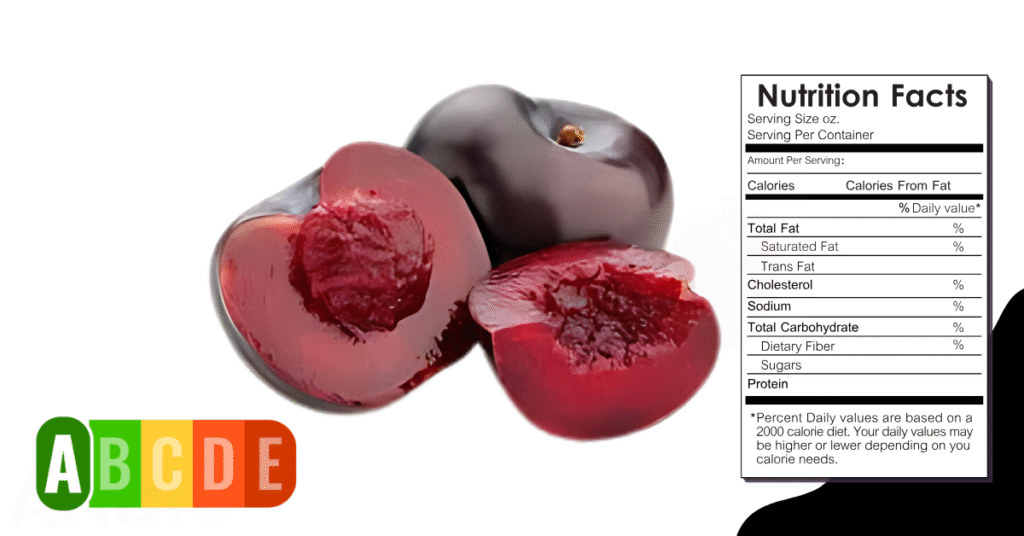
The many health benefits of plums can be better understood by examining their impressive nutritional profile, as analyzed in detail below.
Plum nutrition table
The following table provides a comprehensive look at the nutritional values for one medium-sized plum (approximately 66 grams) and per 100 grams, based on data from the USDA (Cervoni, 2024).
| Nutrient | Per Serving (66g) | DRI % (Serving) | Per 100 grams | DRI % (100g) |
|---|---|---|---|---|
| Calories | 30 | 1.5% | 46 | 2.3% |
| Protein | 0.5g | 1% | 0.7g | 1.4% |
| Carbs | 7.5g | 3% | 11.4g | 4% |
| Total Fat | 0.2g | <1% | 0.3g | <1% |
| Cholesterol | 0mg | 0% | 0mg | 0% |
How many calories are in plums?
Plums are a low-calorie fruit, making them an excellent choice for a healthy diet.
A single medium-sized plum (66g) contains only 30 calories, which is just 1.5% of the recommended daily intake for an average adult on a 2,000-calorie diet. A larger serving of 100 grams of plums contains about 46 calories.
To burn off the 30 calories from one plum, you would need to walk for approximately 8 minutes or run for 3 minutes (Nutritionix, n.d.).
How much protein is in plums?
Plums are not a significant source of protein.
One medium plum provides about 0.5 grams of protein, which accounts for roughly 1% of your daily needs. A 100-gram portion contains slightly more, at 0.7 grams. This makes them a minor contributor to your overall protein intake.
How many carbs are in plums?
Carbohydrates are the primary macronutrient in plums. A medium plum has 7.5 grams of carbohydrates, which is 3% of the daily recommended intake.
Of these carbohydrates, about 0.9 grams come from dietary fiber, and 6.6 grams are naturally occurring sugars (Cervoni, 2024). Due to their fiber content, plums have a low glycemic load, meaning they don’t cause sharp spikes in blood sugar.
How much fat is in plums?
Plums are virtually a fat-free food. A medium plum contains a negligible 0.2 grams of total fat.
The fat content is primarily composed of healthier monounsaturated fats. They contain no saturated fat.
| Fat Type | Per Serving (66g) |
|---|---|
| Total Fat | 0.2g |
| Saturated Fat | 0g |
| Monounsaturated Fat | 0.1g |
| Polyunsaturated Fat | 0g |
Are plums high in cholesterol?
Plums are entirely free of cholesterol.
Like all plant-based foods, plums contain 0mg of cholesterol per serving. This makes them a heart-healthy choice that can be safely included in a diet aimed at managing cholesterol levels.
Minerals in plums
Plums provide several essential minerals that contribute to bodily functions, from nerve signaling to bone health.
| Mineral | Health Benefit | Amount (per 100g) | DRI % (100g) |
|---|---|---|---|
| Potassium | Regulates blood pressure and fluid balance. | 157mg | 3% |
| Copper | Aids in forming red blood cells and maintaining nerve cells. | 0.057mg | 6% |
| Manganese | Supports bone formation and metabolism. | 0.052mg | 2% |
| Phosphorus | Crucial for the formation of bones and teeth. | 16mg | 1% |
| Magnesium | Involved in muscle function and energy production. | 7mg | 2% |
While not a powerhouse of minerals in a single serving, plums contribute to your daily intake of important nutrients like potassium and copper. These minerals work together to support cardiovascular health, immune function, and the structural integrity of your body.
Vitamins in plums
Plums are a good source of several key vitamins, particularly vitamins C and K.
| Vitamin | Health Benefit | Amount (per 100g) | DRI % (100g) |
|---|---|---|---|
| Vitamin C | Boosts the immune system and skin health. | 9.5mg | 11% |
| Vitamin K | Essential for blood clotting and bone health. | 6.4mcg | 5% |
| Vitamin A | Supports vision and immune function. | 17mcg | 2% |
The standout vitamin in plums is vitamin C, a powerful antioxidant. You also get a healthy dose of vitamin K, which is crucial for bone metabolism and preventing blood clots. Vitamin A supports good vision, especially in low light.
Plums Risks and Side Effects
While plums are generally safe and healthy, some individuals may experience adverse effects. Plums contain sorbitol, a sugar alcohol that can cause gas, bloating, and diarrhea, particularly in those with Irritable Bowel Syndrome (IBS) or other digestive sensitivities (Cervoni, 2024).
For some, plums can trigger an allergic reaction. This is often linked to birch-pollen allergy, a condition known as oral allergy syndrome. Symptoms typically appear within 15 minutes of eating raw plums and include itching or swelling in the mouth and throat (Cervoni, 2024). The protein responsible for this reaction is destroyed by heat, so individuals with this specific allergy can often enjoy cooked plums without issue. More severe, non-pollen-related allergies exist and require complete avoidance of the fruit.
Additionally, because dried plums (prunes) are a good source of vitamin K, which aids in blood clotting, individuals taking blood-thinning medications like Warfarin should be mindful of their intake. A consistent, moderate consumption is key to avoid interfering with the medication’s effectiveness (Health.com, 2024).
Debunking myths about plums
Myth: Sugar plums are plums coated in sugar.
Fact: The term “sugar plum” actually refers to a type of small, round hard candy made from boiled sugar, often with a nut or spice at the center. It has no connection to the actual plum fruit (Cervoni, 2024).
Myth: Swallowing a plum pit is highly toxic.
Fact: While the seed inside the pit contains amygdalin, which the body can convert to cyanide, unintentionally swallowing a whole pit is unlikely to be harmful as it will typically pass through the digestive system intact. The danger arises only if the pit is crushed or chewed, releasing the compounds inside, and even then, a significant quantity would need to be ingested to cause harm. The primary risk of swallowing a whole pit is choking (Medical News Today, 2021).
Myth: The white powder on plum skin must be washed off because it is a pesticide.
Fact: That white, waxy film is a natural coating called “bloom.” The plum produces it to protect itself from insects and bacteria and to help retain moisture. It is completely edible and is actually a sign of freshness (Cervoni, 2024).
Plums Substitutes
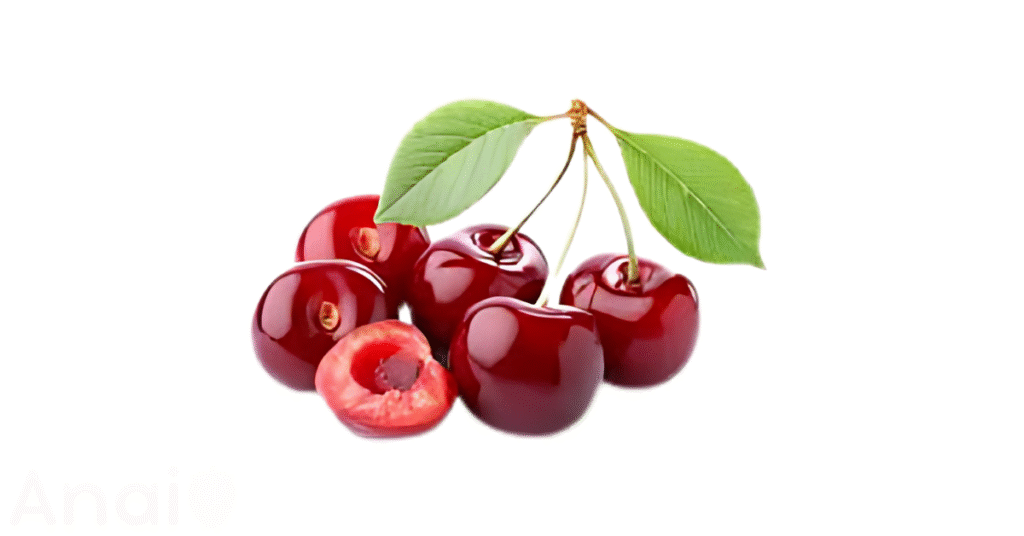
If a recipe calls for plums and you don’t have any on hand, other stone fruits can work well as a replacement. The best substitute depends on whether the dish is sweet or savory and the desired texture.
| Fruit (100g) | Calories | Fiber (g) | Sugar (g) | Vitamin C (mg) |
|---|---|---|---|---|
| Plum | 46 | 1.4 | 10 | 9.5 |
| Peach | 39 | 1.5 | 8.4 | 6.6 |
| Apricot | 48 | 2.0 | 9.0 | 10.0 |
| Prune | 240 | 7.1 | 38 | 0.6 |
| Cherry | 63 | 2.1 | 13 | 7.0 |
For a fresh, juicy substitute, peaches are an excellent choice. They are similar in water content and texture, making them ideal for salads, grilling, or fresh salsas. Their lower sugar content offers a slightly less sweet profile. A drawback is that their flavor is milder than that of a tart plum, and their skin is fuzzy, which some may find unpleasant.
In baked goods like pies, tarts, and cobblers, apricots are a fantastic alternative. They offer a similar sweet-tart balance and hold their shape well when cooked. They are also slightly higher in fiber. However, fresh apricots have a very short season and can be harder to find than plums. They also tend to be smaller, so you may need more of them to fill a recipe.
When cooking savory dishes, especially slow-cooked meats like pork or duck, prunes (dried plums) are often the best option. They provide a concentrated sweetness and rich flavor that infuses deeply into sauces and meats. Their high fiber content is a major benefit. The main drawback is their high sugar and calorie density, so they should be used more sparingly than fresh plums (Filippone, 2019).
For desserts and sauces, sweet cherries can be used. They bring a vibrant color and a distinctly sweet flavor profile. They work well in pies and as a topping for ice cream. The biggest drawback is the labor-intensive process of pitting them. Their flavor, while delicious, is also quite different from plums, which will noticeably change the final dish.
Popular Plum Diets
How to add plums safely into your diet? Choosing the right diet is important to ensure that you are meeting your nutritional needs while also enjoying the foods you eat. Here are a few of the available plums-friendly diet options:
- The High-Fiber Diet for Digestive Health
- The Low-Calorie Diet for Weight Management
- The Bone Health Diet (Prune-Focused)
- The Heart-Healthy Diet (e.g., DASH, Mediterranean)
| Diet Type | Primary Goal | Role of Plums/Prunes | Benefits | Drawbacks |
|---|---|---|---|---|
| High-Fiber | Improve digestive regularity and prevent constipation. | Excellent source of soluble and insoluble fiber; prunes are particularly effective. | Promotes gut health, helps manage weight, can lower cholesterol. | Can cause gas and bloating if fiber is increased too quickly. |
| Low-Calorie | Create a calorie deficit to promote weight loss. | Low-calorie, high-water content fruit that increases satiety. | Effective for weight loss; plums provide nutrients while keeping calories low. | Requires careful portion control, especially with higher-calorie prunes. |
| Bone Health | Prevent bone loss and reduce the risk of osteoporosis. | Prunes are a key component due to their high vitamin K and mineral content. | Supported by research to improve bone mineral density. | Requires consistent, long-term consumption of prunes (e.g., 50-100g daily). |
| Heart-Healthy | Lower blood pressure and cholesterol levels. | Plums provide potassium, fiber, and heart-protective antioxidants. | Aligns with proven dietary patterns like DASH and Mediterranean. | Part of a broader lifestyle change; benefits come from the overall diet, not just plums. |
The High-Fiber Diet is centered on increasing the intake of dietary fiber to support gut health and prevent constipation. Plums, and especially prunes, are a perfect fit for this diet. Prunes are well-known for their natural laxative effect, a benefit attributed to their high fiber and sorbitol content. Research has even suggested that prunes can be more effective than psyllium, a common fiber supplement, for relieving constipation (Healthline, n.d.).
For those focused on weight management, a Low-Calorie Diet can be effective. Plums are ideal for this approach. A single plum contains only about 30 calories, making it a satisfying, sweet snack that won’t derail your calorie goals. Their fiber and water content help you feel full, which can prevent overeating. While fresh plums are excellent, portion control is crucial for dried plums (prunes), as they are more calorie-dense.
The Bone Health Diet specifically leverages the benefits of prunes to combat bone density loss. Research has shown that daily consumption of prunes can help prevent and even reverse bone loss, particularly in postmenopausal women (Healthline, n.d.). This diet typically involves eating 50 to 100 grams of prunes (about 5 to 10 prunes) daily. It’s a long-term strategy that relies on the unique combination of vitamins and minerals in prunes, including vitamin K, potassium, and magnesium.
Plums are also a natural addition to any Heart-Healthy Diet, such as the DASH (Dietary Approaches to Stop Hypertension) or Mediterranean diets. These eating patterns emphasize fruits, vegetables, and whole foods. Plums contribute by providing potassium to help manage blood pressure, soluble fiber to lower cholesterol, and antioxidants to reduce inflammation, all of which are crucial factors for maintaining cardiovascular health.
How to Cook Plums?
Cooking plums can soften their texture and deepen their flavor, making them suitable for a wide range of dishes. However, different cooking methods affect their nutrient content differently.
Raw plums offer the most nutritional value. Eating them fresh preserves all their heat-sensitive vitamins, like vitamin C, and delicate antioxidants. Simply wash the fruit, remove the pit, and enjoy it as a snack or slice it into salads for a sweet and tangy crunch.
Roasted plums develop a rich, concentrated flavor. To roast, halve and pit the plums, toss them with a touch of honey or wine, and bake until tender. Roasting causes some loss of vitamin C, but it’s generally better for nutrient retention than boiling. A key tip is to watch them closely, as they can turn to mush quickly; check them after 15 minutes (Lebovitz, 2020). This method is perfect for creating a warm topping for ice cream or a savory side for grilled meats.
Poached or stewed plums become incredibly soft and create their own delicious syrup. This method involves simmering halved plums in a liquid like water, orange juice, or wine with sugar and spices. While effective, poaching can cause water-soluble nutrients like vitamin C and B vitamins to leach into the cooking liquid. To retain these nutrients, be sure to consume the syrup along with the fruit. For a festive twist, you can replace half the water with mulled wine (Hackworthy, 2022).
Sautéed plums are a quick and simple way to cook the fruit. Slicing plums and cooking them in a pan with a little butter and honey takes only about five minutes. This method offers a great balance between speed and flavor development. Because the cooking time is short, nutrient loss is minimized compared to longer cooking methods like boiling. For a savory take, try swapping vanilla for fresh thyme or rosemary to pair with cheese or salads (ful-filled.com, 2021).
Easy Plum Recipes
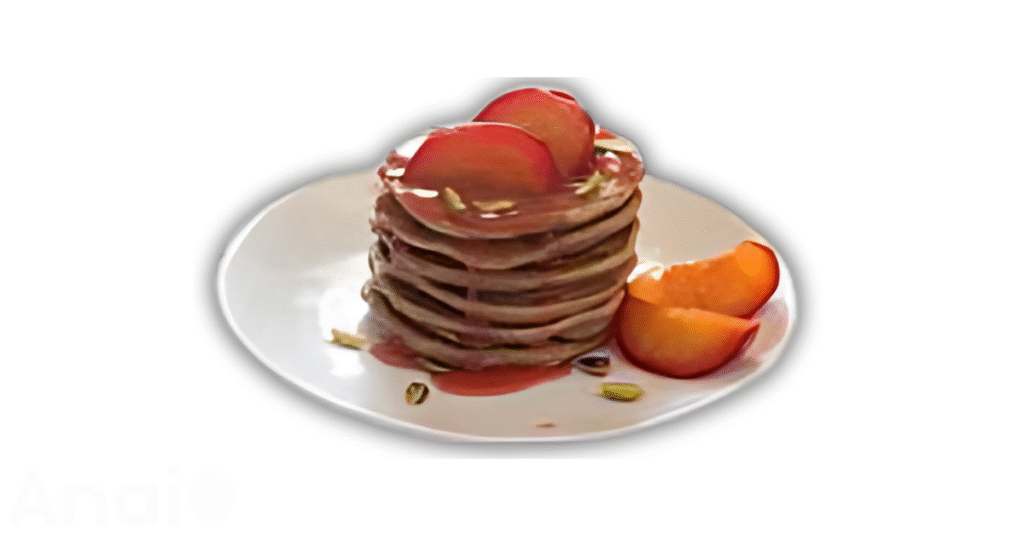
Incorporating plums into your daily meals is a delicious way to boost your fruit intake without compromising on taste.
Breakfast ideas with plums
Sautéed or stewed plums on yogurt are a fantastic way to start the day. The warm, syrupy fruit pairs beautifully with cold, creamy Greek yogurt or oatmeal. It’s a quick and elegant breakfast that feels indulgent but is packed with nutrients.
Plum jam on toast is a classic. Using a simple, two-ingredient recipe without pectin allows the natural flavor of the plums to shine through (Kravchuk, 2021). Spread it on whole-grain toast or crepes for a sweet and satisfying meal.
Plum-topped pancakes or waffles elevate a weekend breakfast. Drizzle warm, stewed plums over a fresh stack of pancakes or cinnamon French toast for a burst of fruity flavor that complements the dish perfectly.
Lunch ideas with plums
A plum and goat cheese salad offers a perfect balance of sweet, tangy, and savory. Sliced fresh plums, crumbled goat cheese, and toasted nuts on a bed of greens, drizzled with a light vinaigrette, makes for a sophisticated and refreshing lunch.
A fresh plum salsa is a creative addition to grilled chicken or fish. Chop fresh plums with red onion, cilantro, jalapeno, and a squeeze of lime juice for a vibrant salsa that is both sweet and spicy.
Dinner ideas with plums
Roasted plums with chicken or pork create a simple yet elegant main course. The tartness of the plums cuts through the richness of the meat, and the roasted fruit creates a natural, flavorful sauce.
A savory plum cobbler is an unexpected twist on a classic dessert. While fruit cobblers are typically sweet, using plums in a savory version with herbs can create a unique side dish, similar to a tomato cobbler (Saving Room for Dessert, n.d.).
Duck with a plum glaze is a classic pairing for a reason. The sweetness of a plum sauce or glaze complements the rich, fatty flavor of duck beautifully, creating a restaurant-quality meal at home.
Simple tips to add plums to your diet
For those who are too busy to implement the previous meal ideas, there are still many simple ways to add plums to your diet:
- Eat a fresh plum as a quick, on-the-go snack.
- Add a few slices of plum to your water or iced tea for a subtle, fruity infusion.
- Blend fresh or frozen plums into your morning smoothie.
- Keep a bag of dried plums (prunes) at your desk for an easy, fiber-rich snack.
- Slice plums and add them to your favorite cereal or granola.
- Use prune puree as a healthy substitute for butter or oil in baked goods like brownies and muffins.
Plum Storage Tips
Knowing how to cook plums is only part of the equation; it’s just as important to master plum storage tips to make those meals last for longer.
Shelf life of plums
- At room temperature (unripe): 1 to 3 days, or until they yield to gentle pressure.
- In the refrigerator (ripe): 2 to 4 weeks.
- In the freezer: Up to 12 months.
How to store plums?
The best way to store plums depends on their ripeness. If your plums are still firm, they need to be ripened at room temperature. Placing them in a loosely closed paper bag can speed up this process by trapping the ethylene gas they naturally release. Keep them out of direct sunlight to prevent them from rotting before they ripen.
Once the plums are fragrant and slightly soft to the touch, they are ripe and should be moved. The key to preserving ripe plums is to prevent bruising and slow down the ripening process. Storing them loosely and with care in the refrigerator is the best way to extend their life.
How to refridgerate plums?
To keep ripe plums fresh for as long as possible, you should store them in the refrigerator.
- Place ripe plums in an open plastic bag or, for better protection, in an empty egg carton to prevent bruising.
- Put them in the crisper drawer of your refrigerator.
- Ensure the refrigerator is clean and free of strong odors, as plums can absorb them.
- Eat the plums within two to four weeks for the best flavor and texture.
How to freeze plums?
Freezing is an excellent method for long-term storage, perfect for enjoying a taste of summer in the middle of winter.
- Start with ripe, flavorful plums. Wash and dry them thoroughly.
- Slice the plums into halves or wedges and remove the pits.
- Arrange the plum slices in a single layer on a baking sheet.
- Freeze the sheet for a few hours, or until the slices are solid.
- Transfer the frozen plum slices to a freezer-safe bag or container, removing as much air as possible.
- Label the bag with the date and store it in the freezer for up to one year.
Signs of Spoilage in plums
It’s important to recognize when a plum is past its prime. Discard any plums that show these signs of spoilage:
- Visible mold, which often looks like white or gray fuzzy patches.
- Significant soft spots, mushy texture, or bruising.
- Discoloration or dark blemishes on the skin.
- A foul, fermented, or off-smell.
- Juice seeping from the skin, indicating the fruit is overripe and breaking down.
10 Genius Plum Home Remedies
Are there any less-known tips to unlock the nutritious profile of plums? The following plums remedies can have a positive effect on overall well-being.
- Constipation Relief Tonic. For a natural and effective laxative, drink 4 to 8 ounces of 100% prune juice each morning. The combination of fiber and sorbitol helps stimulate a bowel movement. For a milder effect, especially for children, start with 2 to 4 ounces. Store opened prune juice in the refrigerator.
- Digestive Aid with Stewed Plums. Gently simmer halved, pitted plums in a small amount of water until soft. This method is gentler on the stomach than raw prunes. Eating a few spoonfuls after a meal can aid digestion. Store stewed plums in an airtight container in the refrigerator for up to a week.
- Daily Bone Health Booster. To support bone density, make it a habit to eat 5 to 10 dried plums (prunes) every day. Research shows this can help prevent bone loss, especially in postmenopausal women. Store prunes in a cool, dark place in an airtight container.
- Anxiety-Soothing Plum Infusion. When feeling anxious, a warm, soothing drink can help. Gently heat a cup of water with a few slices of fresh plum and a cinnamon stick. Let it steep for 5-10 minutes. The antioxidants in plums may help combat the oxidative stress linked to anxiety.
- Pre-Workout Energy Snack. For a quick and natural energy boost before exercise, eat one or two fresh plums. The natural sugars provide readily available energy, while the fiber ensures it’s released steadily.
- Heart Health Elixir. Infuse a pitcher of water with slices of fresh plum and a few sprigs of mint. This encourages hydration while providing potassium and antioxidants that support cardiovascular health. Keep refrigerated and consume within two days.
- Skin-Brightening Face Mask. Mash one ripe, peeled plum into a paste. Apply it to your face, avoiding the eye area, and leave it on for 15 minutes before rinsing. The vitamin C and antioxidants can help brighten the complexion. Perform a patch test first to ensure no skin irritation.
- Immunity-Boosting Smoothie. Blend a handful of frozen plum wedges, a small orange, a knob of ginger, and a splash of water. This combination is rich in vitamin C and anti-inflammatory compounds to help support your immune system.
- Sore Throat Gargle. Warm a half-cup of prune juice and mix it with a teaspoon of honey. The warm, syrupy liquid can provide temporary relief by coating and soothing a sore throat. Do not give honey to children under one year of age.
- Indigestion Calmer. For mild indigestion, eating a single stewed plum can be beneficial. The fruit’s gentle fiber can help regulate the digestive system without being overly harsh.
Plums and Weight Management

There are multiple health benefits, and home remedies using plums, but what is their role in weight management? This section will analyze plums’ potential impact on weight loss, low-calorie diets, satiety, and metabolism.
Can plums help with weight loss?
Plums can be a valuable addition to a weight loss diet due to their unique nutritional properties. Their low-calorie count combined with high water and fiber content makes them a strategic choice for shedding pounds. As highlighted in a study published in Critical Reviews in Food Science and Nutrition, the nutrients in prunes may even help control obesity (Healthline, 2017). By providing volume and nutrients without excess calories, plums help create the calorie deficit necessary for weight loss while still nourishing the body.
Plums in low-calorie diets
With just 30 calories in one medium-sized plum, they fit seamlessly into any low-calorie eating plan (BetterMe, 2024). This allows for a satisfyingly sweet snack without a significant caloric impact. In contrast, their dried counterparts, prunes, are more calorie-dense, containing about 67 calories per one-ounce serving (BetterMe, 2024). Therefore, while both are nutritious, fresh plums are the superior choice for volume eating in a calorie-controlled diet.
Plums and satiety
The feeling of fullness, or satiety, is crucial for controlling appetite and managing weight, and plums excel in this area. The fiber in plums slows down digestion and adds bulk to your meal, which helps you feel full for a longer period (Medicinenet.com, n.d.). This satiating effect can curb your appetite and reduce the likelihood of overeating, making it easier to stick to your weight management goals.
Plums and metabolism
Plums support a healthy metabolism, particularly through blood sugar regulation. Research suggests plums do not cause a rapid spike in blood sugar, partly due to their fiber content and their ability to boost adiponectin, a hormone that helps regulate blood sugar (Bonvissuto, 2023). Stable blood sugar levels are essential for preventing insulin resistance and minimizing fat storage. Furthermore, the B vitamins found in prunes, such as niacin and vitamin B6, play a direct role in converting food into energy, which is the very essence of metabolism.
Plums for Health Conditions
While weight management is important, do plums have an effect in more serious health conditions? Here’s what the scientific literature has to say:
Plums and diabetes
Plums can be a beneficial fruit for those managing or trying to prevent type 2 diabetes. Despite their sweetness, plums and prunes have a low glycemic index, meaning they do not cause a rapid increase in blood sugar levels after consumption. This is largely due to their high fiber content, which slows down the rate at which the body absorbs carbohydrates (greatist.com, 2021). Furthermore, some research suggests that plums may increase the body’s levels of adiponectin, a hormone that plays a crucial role in blood sugar regulation (Bonvissuto, 2023).
Plums and heart health
Consuming plums and prunes regularly may have a protective effect on the heart. They are rich in potassium, a mineral that helps control blood pressure by lessening the tension in blood vessel walls and helping the body excrete sodium. A study published in 2010 found that participants who consumed prunes and prune juice had significantly lower blood pressure and reduced “bad” LDL cholesterol levels (greatist.com, 2021). These effects are likely due to the powerful combination of fiber, potassium, and antioxidants found in the fruit.
Plums and digestive issues
For digestive health, particularly constipation, prunes are a well-documented remedy. Their effectiveness comes from a dual-action approach: high fiber content and sorbitol. The insoluble fiber adds bulk to stool, while sorbitol, a sugar alcohol, acts as a natural laxative. A study in Alimentary Pharmacology and Therapeutics found that prunes were more effective at treating constipation than psyllium, a common fiber supplement (greatist.com, 2021).
Plums and inflammation
Plums are rich in antioxidants, particularly polyphenols like anthocyanins, which have potent anti-inflammatory properties. Chronic inflammation is a root cause of many diseases, and a diet rich in anti-inflammatory foods can help mitigate this risk. A test-tube study from 2015 showed that polyphenols from prunes were able to significantly reduce inflammatory markers associated with joint and lung diseases, though more human research is needed to confirm these effects (greatist.com, 2021).
Plums and cancer prevention
The high antioxidant content of plums may also play a role in cancer prevention. These compounds protect cells from damage caused by free radicals, which can lead to the development of cancer. While research is still in its early stages, some laboratory studies have shown promising results. For instance, a 2010 test-tube study found that plum and peach extracts were effective at killing aggressive breast cancer cells while leaving healthy cells unharmed (greatist.com, 2021). It is important to note that these are preliminary findings and do not mean plums can treat cancer.
Overall, the scientific evidence for the health benefits of plums is promising but still developing. A systematic review published in Phytotherapy Research concluded that while consumption is associated with improved cognitive function, bone health, and cardiovascular risk factors, the overall level of evidence remains low and requires further confirmation (Igwe & Charlton, 2016).
| Health Category | Benefits | Type of Study | Quality of Evidence | Sources |
|---|---|---|---|---|
| Diabetes | Helps regulate blood sugar levels, low glycemic index. | Human cohort studies | Moderate | Cervoni, 2024; Bonvissuto, 2023 |
| Heart Health | May lower blood pressure and LDL cholesterol. | Human clinical trials, animal studies | Moderate but needs more human trials | Smith-Haghighi, 2021; Bonvissuto, 2023 |
| Digestive Health | Relieves constipation effectively. | Human clinical trials | High (for prunes) | Weeks, 2023 |
| Inflammation | Reduces inflammatory markers. | Test-tube studies | Low (preliminary) | Smith-Haghighi, 2021 |
| Cancer Prevention | May have anti-cancer properties. | Test-tube studies | Low (preliminary) | Zumpano, 2025; Elliott, 2025 |
Closing Thoughts on Plum Nutrition
Throughout this guide, we’ve explored the world of plums, from their 13 functional health benefits and detailed nutrition facts to potential risks and side effects. We’ve covered plum substitutes, popular plum-friendly diets, essential storage tips, 10 genius home remedies, their role in weight management, and their potential use for various health conditions.
Here are a few of the most interesting facts about this versatile fruit:
- A single medium plum contains only 30 calories, making it a perfect low-calorie snack.
- The white, powdery film on a plum’s skin, known as “bloom,” is a natural, edible coating that protects the fruit and is a sign of freshness.
- Dried plums, or prunes, have been shown in studies to be more effective for relieving constipation than psyllium, a common fiber supplement.
- Eating 50-100 grams of prunes daily may help reduce bone loss and improve bone density.
- The candy known as a “sugar plum” is not actually made from plums but is a type of hard candy.
This article was last updated in December 2025 to ensure you have the most current and accurate information.
For the latest in nutrition science and practical well-being tips, follow Anai.ai and stay informed.
Plum Nutrition FAQs
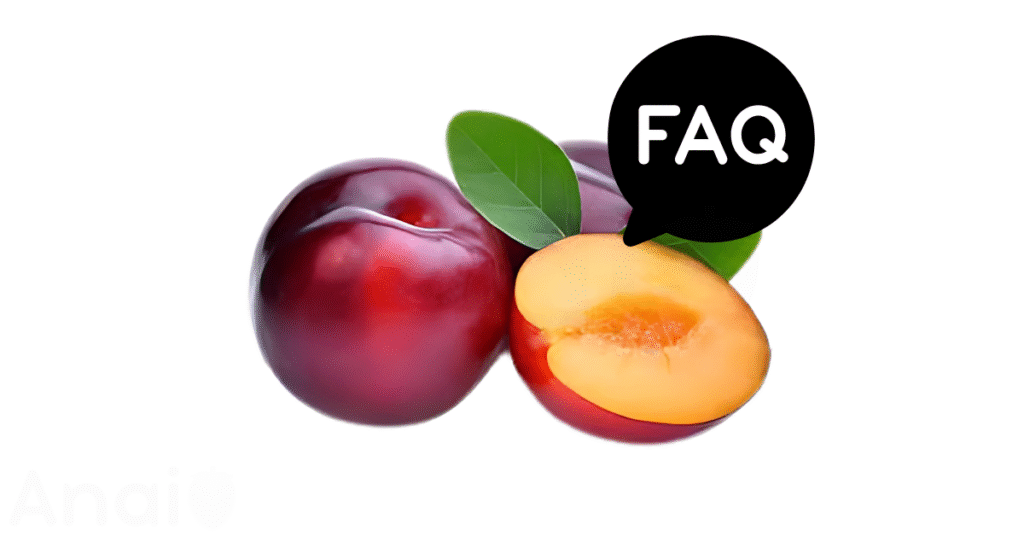
Now that we’ve explored the detailed science behind plum nutrition, let’s address some common, practical questions. This section provides concise, fact-driven answers to frequent queries about plum consumption, safety, and storage. Find clear responses below to help you make the most of this nutritious fruit.
What are plums good for?
Plums are excellent for promoting digestive health, bone strength, and cardiovascular wellness. Their high fiber and sorbitol content make them a potent natural remedy for constipation, with a single cup of prunes providing an impressive 12 grams of fiber. For bone health, the significant amount of vitamin K in plums is crucial, and studies show that a daily intake of 50-100 grams of prunes can help reduce bone loss. Additionally, with over 100 mg of potassium per fruit, plums help regulate blood pressure, supporting a healthy heart.
Are plums healthy?
Yes, plums are incredibly healthy, offering a wealth of nutrients in a low-calorie package. A single medium plum contains only 30 calories but is packed with over 15 different vitamins and minerals. They are a good source of Vitamin C, providing up to 10% of your daily needs in one fruit, which is vital for immune function. Plums are also rich in antioxidants like polyphenols and anthocyanins, which protect your cells from damage.
Are plums fattening?
No, plums are not fattening and can be a great addition to a weight management plan. They are a low-calorie and low-fat food, with one medium plum containing just 30 calories and less than 0.5 grams of fat. Their high fiber and water content helps you feel full and satisfied, which can prevent overeating and support weight loss goals.
Who should avoid plums?
Individuals with a birch-pollen allergy should be cautious, as they may experience oral allergy syndrome from eating raw plums. People with Irritable Bowel Syndrome (IBS) or a sensitivity to sugar alcohols might also want to limit their intake, as the sorbitol in plums can cause bloating and diarrhea. Furthermore, due to their high Vitamin K content, those taking blood-thinning medications like Warfarin should consult their doctor to ensure a consistent intake.
Can I eat plums daily?
Yes, eating plums daily is generally safe and can be very beneficial for your health. Consistent daily consumption is linked to improved bone density and better digestive regularity, with some studies recommending a daily intake of 5-10 fresh plums or about 1/4 to 1/2 cup of prunes. Sticking to this moderate amount allows you to reap the benefits without experiencing the potential digestive side effects from too much fiber and sorbitol.
Can dogs eat plums?
The fleshy part of a plum is generally safe for dogs to eat in small, moderate amounts. However, the plum pit is extremely dangerous as it contains cyanide and poses a serious choking hazard. The stem and leaves of the plum tree are also toxic to dogs. Therefore, if you share a plum with your dog, you must remove the pit, stem, and leaves and only offer the fruit’s flesh.
Can cats eat plums?
No, cats should not eat any part of a plum. While the fruit’s flesh is not toxic, the pit, stem, and leaves contain cyanide, which is poisonous to cats and can be fatal even in small doses. The pit also presents a significant choking hazard. It is best to keep all parts of the plum away from cats to ensure their safety.
How long do plums last in the fridge?
Once ripe, plums can be stored in the refrigerator to significantly extend their shelf life. When kept in the crisper drawer, ripe plums will remain fresh for approximately 2 to 4 weeks. Storing them in an open plastic bag or an egg carton helps prevent bruising and maintains their quality for longer.
Can you freeze plums?
Yes, you can freeze plums, which is an excellent way to preserve their flavor for future use. For the best results, plums should be washed, pitted, and sliced before being frozen. Properly stored in an airtight freezer bag, plums can maintain their quality for up to 12 months, allowing you to enjoy them long after their peak season has ended.
How to tell if plums are bad?
You can easily tell if plums are bad by checking for a few key indicators of spoilage. Discard any plums that have visible mold, significant soft spots, or a mushy texture. A sour, fermented smell is another clear sign the fruit has gone bad, as is any juice seeping from the skin, which indicates the plum is overripe and breaking down.
How long are plums good for?
The lifespan of a plum varies greatly depending on its storage conditions. Unripe plums will ripen at room temperature within 1 to 3 days. Once ripe, they can be transferred to the refrigerator, where they will last for 2 to 4 weeks. For long-term storage, frozen plums can remain in good condition for up to one year.
How to keep plums fresh?
To keep plums fresh, you should manage their ripening process. Allow firm plums to ripen on the counter for a couple of days, and you can place them in a paper bag to trap ethylene gas and speed up ripening. Once they are slightly soft, move them into the refrigerator’s crisper drawer, which will halt the ripening process and keep them fresh for up to 4 weeks.

